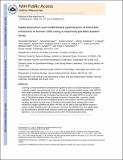Rapid dissection and model-based optimization of inducible enhancers in human cells using a massively parallel reporter assay
Author(s)
Melnikov, Alexandre; Murugan, Anand; Zhang, Xiaolan; Tesileanu, Tiberiu; Wang, Li; Rogov, Peter; Feizi-Khankandi, Soheil; Gnirke, Andreas; Callan Jr, Curtis G.; Kinney, Justin B.; Kellis, Manolis; Lander, Eric S.; Mikkelsen, Tarjei Sigurd, 1978-; ... Show more Show less
DownloadLander_Rapid dissection.pdf (1.581Mb)
OPEN_ACCESS_POLICY
Open Access Policy
Creative Commons Attribution-Noncommercial-Share Alike
Terms of use
Metadata
Show full item recordAbstract
Learning to read and write the transcriptional regulatory code is of central importance to progress in genetic analysis and engineering. Here we describe a massively parallel reporter assay (MPRA) that facilitates the systematic dissection of transcriptional regulatory elements. In MPRA, microarray-synthesized DNA regulatory elements and unique sequence tags are cloned into plasmids to generate a library of reporter constructs. These constructs are transfected into cells and tag expression is assayed by high-throughput sequencing. We apply MPRA to compare >27,000 variants of two inducible enhancers in human cells: a synthetic cAMP-regulated enhancer and the virus-inducible interferon-β enhancer. We first show that the resulting data define accurate maps of functional transcription factor binding sites in both enhancers at single-nucleotide resolution. We then use the data to train quantitative sequence-activity models (QSAMs) of the two enhancers. We show that QSAMs from two cellular states can be combined to design enhancer variants that optimize potentially conflicting objectives, such as maximizing induced activity while minimizing basal activity.
Date issued
2012-02Department
Massachusetts Institute of Technology. Computer Science and Artificial Intelligence Laboratory; Massachusetts Institute of Technology. Department of Biology; Massachusetts Institute of Technology. Department of Electrical Engineering and Computer ScienceJournal
Nature Biotechnology
Publisher
Nature Publishing Group
Citation
Melnikov, Alexandre et al. “Systematic Dissection and Optimization of Inducible Enhancers in Human Cells Using a Massively Parallel Reporter Assay.” Nature Biotechnology 30.3 (2012): 271–277. Web.
Version: Author's final manuscript
ISSN
1087-0156
1546-1696